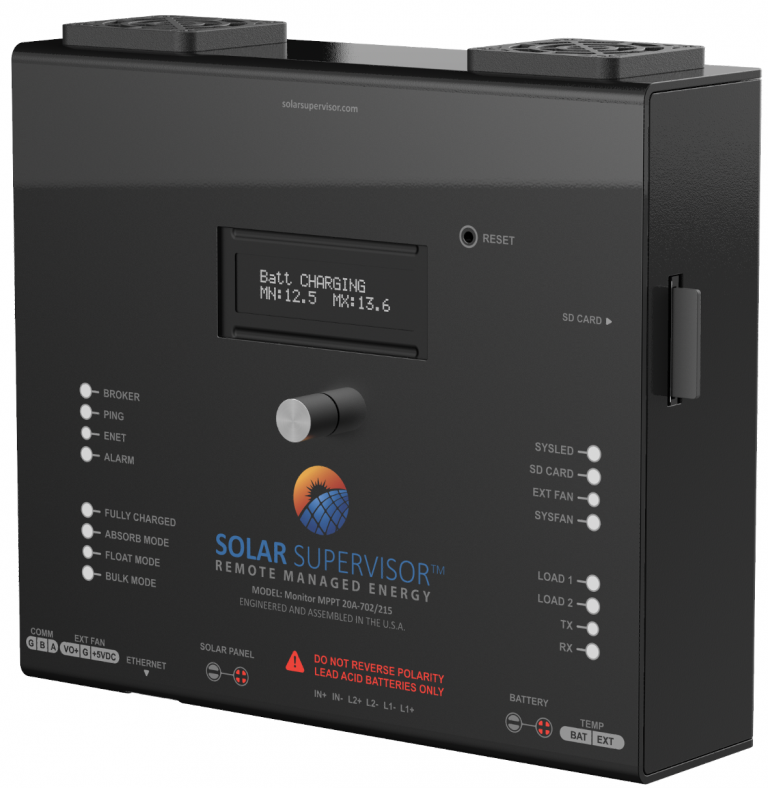WHAT'S INCLuDED?

- SD Card
- External Temperature Sensor
- Battery Temperature Sensor
Request Technical Specifications Brochure >>>
| Technical Specifications | |
| Specification | Description |
| Battery Input | 12/24 Vdc Automatically detects on power up or restart |
| Battery Charge Current | Limited to 16.5 Amps |
| Solar Input | 56 Vdc Max |
| Solar Current | Limited to 13 Amps |
| Charging algorithm | Maximum Power Point Tracking(MPPT) |
| Load-1 |
Priority-1 Load, 8Amps Max, Sheds @ <11.6/23.2vdc, reset @ 12.6/25.2vdc |
| Load-2 |
Priority-2 Load, 8Amps Max, Sheds @ <11.8/23.6vdc, reset @ 12.6/25.2vdc |
| Temperature Range | -30 to +70c |
| Cooling | Dual Device cooling fans |
| Temperature sensors | External Ambient, Battery, MPPT, Device enclosure |
| SD Card | 2gb, Data logger, SYSLOG and reports. 90+ year capacity |
| Tamper Switch Input | Dry Contact NO/NC tamper detection |
| RS485 | Modbus RTU, Device Firmware Updates |
| Modbus RTU BAUD | 4800, 9600, 19200, 38400, 57600, 115200 – N,8,1 |
| LED Battery Indicators | Fully Charged, Bulk/Absorb/Float Mode |
| LED IP Indicators | MQTT Broker Connected, PING, Ethernet Cable attached |
| LED System Indicators | SYSLED, SD CARD DATA |
| LED Cooling Fans Indicators | Device Fans ON/OFF Status, **External Fan ON/OFF Status |
| LED Load Shed Indicators | Load1, Load2 ON/OFF status |
| Protocols | MQTT SPA/B, Modbus RTU/TCP |
*Specifications subject to change without notice ** Not Included
Scrap the guesswork when it comes to designing and understanding why your remote solar system is failing.
A significant cost factor in maintaining a solar system is replacing batteries and sending service personnel to Solar Site locations with unknown problems, potentially costing thousands of dollars per visit.
The Solar SupervisorTM (Patent Pending) series of monitoring, charging, and analytic products significantly reduces and can even end the lack of visibility into your solar generation system performance.
With dual load outputs, loads can be separated to allow critical equipment to take power priority.
Critical battery discharge limits keep batteries from being discharged to irreversible damaging conditions.
Automated system predictions make real-time, dynamic, predictions on the proper solar panel and battery SIZE to maintain power across your desired days of no or low solar exposure.
The system tells SCADA operators how much battery and solar capacity to add.
| System Vital Signs | |
| Parameter | Measurements |
| Battery |
|
| Solar Panel |
|
| Real-time System Predictions |
|
| Loads |
|
| Temperatures |
|
| Timers |
|
| Alarms |
|
*Not all vital signs measurements listed
